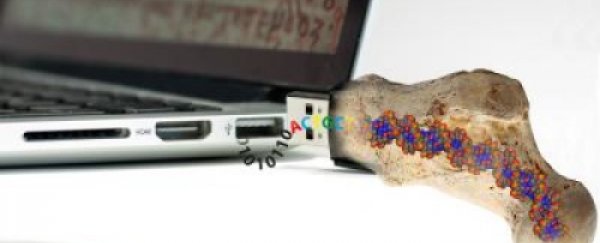When you think of humanity's legacy, the most powerful message for us to leave behind for future civilisations would surely be our billions of terabytes of data. But right now the hard drives and discs that we use to store all this information are frustratingly vulnerable, and unlikely to survive more than a couple of hundred years.
Fortunately scientists have built a DNA time capsule that's capable of safely preserving all of our data for more than a million years. And we're kind of freaking out over how huge the implications are.
Researchers already knew that DNA was ideal for data storage. In theory, just 1 gram of DNA is capable of holding 455 exabytes, which is the equivalent of one billion gigabytes, and more than enough space to store all of Google, Facebook and pretty much everyone else's data.
Storing information on DNA is also surprisingly simple - researchers just need to program the A and C base pairs of DNA as a binary '0', and the T and G as a '1'. But the researchers, led by Robert Grass from ETH Zürich in Switzerland, wanted to find out just how long this data would last.
DNA can definitely be durable - in 2013 scientists managed to sequence genetic code from 700,000-year-old horse bones - but it has to be preserved in pretty specific conditions, otherwise it can change and break down as it's exposed to the environment. So Glass's team decided to try to replicate a fossil, to see if it would help them create a long-lasting DNA hard drive.
"Similar to these bones, we wanted to protect the information-bearing DNA with a synthetic 'fossil' shell," explained Grass in a press release.
In order to do that, the team encoded Switzerland's Federal Charter of 1921 and The Methods of Mechanical Theorems by Archimedes onto a DNA strand - a total of 83 kilobytes of data. They then encapsulated the DNA into tiny glass spheres, which were around 150 nanometres in diameter.
The researchers compared these glass spheres against other packaging methods by exposing them to temperatures of between 60 and 70 degrees Celsius - conditions that replicated the chemical degradation that would usually occur over hundreds of years, all crammed into a few destructive weeks.
They found that even after this sped-up degradation process, the DNA inside the glass spheres could easily be extracted using a fluoride solution, and the data on it could still be read. In fact, these glass casings seem to work much like fossilised bones.
Based on their results, which have been published in Angewandte Chemie, the team predicts that data stored on DNA could survive over a million years if it was stored in temperatures below -18 degrees Celsius, for example, in a facility like the Svalbard Global Seed Vault, which is also known as the 'Doomsday Vault'. They say it could last 2,000 years if stored somewhere less secure at 10 degrees Celsius - a similar average temperature to central Europe.
The tricky part of this whole process is that the data stored in DNA needs to be read properly in order for future civilisations to be able to access it. And despite advances in sequencing technology, errors still arise from DNA sequencing.
The team overcame this by embedding a method for correcting any errors within the glass spheres, based on the Reed-Solomon Codes, which help researchers transmit data over long distances. Basically, additional information is attached to the actual data, to help people read it on the other end.
This worked so well that even after the test DNA had been kept in scorching and degrading conditions for a month, the team could still read Switzerland's Federal Charter and Archimedes' wise words at the end of the study.
The other major problem, which is not so easy to overcome, is the fact that storing information on DNA is still extremely expensive - it cost around US$1,500 just to encode the 83 kilobytes of data used in this study. Hopefully this cost will go down as we get better at writing information onto DNA. Rsearchers out there are already storing books onto DNA, and the band OK Go are also writing their new album into genetic information.
The question is, what would Grass store, now that he's developed this mind-blowing time capsule? The documents in Unesco's Memory of the World Programme, and… Wikipedia, he says.
"Many entries are described in detail, others less so. This probably provides a good overview of what our society knows, what occupies it and to what extent," said Grass in the release.
It's ridiculously cool to think that even if we do wipe ourselves off the face of the Earth, our civilisation might still live on for millennia to come in the form of Wikipedia pages and Facebook updates.
We really are (almost) infinite.
Source: New Scientist
